Dinshare Cordless Electric Ratchet Wrench JC-116 Manual | Assembling & Operating
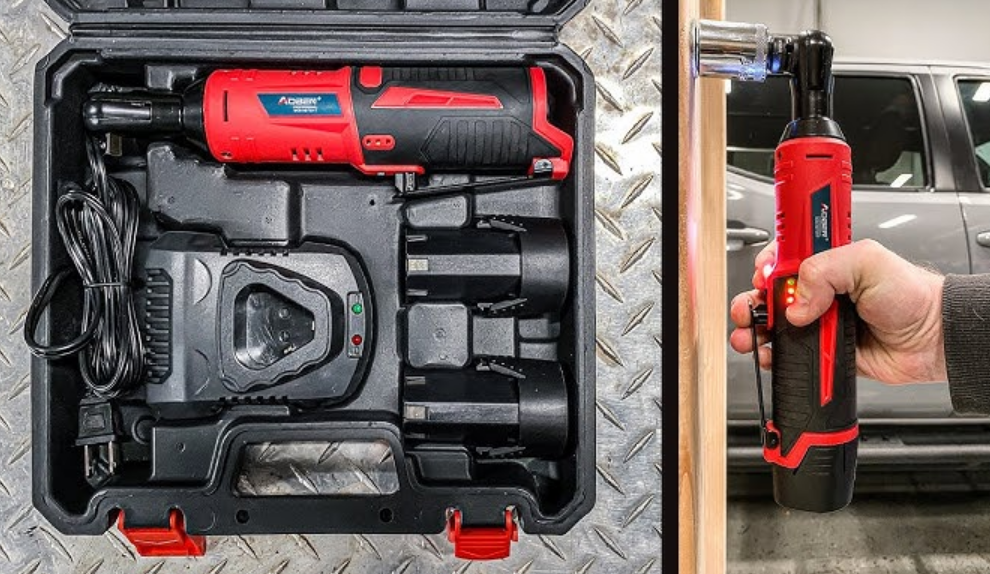
Content
Introducing the Dinshare Cordless Electric Ratchet Wrench JC-116
This powerful cordless ratchet wrench is designed for heavy-duty use and is suitable for both professional and DIY use. With an estimated price range of $50 to $70 and a launch date set for August 2023, this product is a must-have for anyone looking to add to their tool collection.
Detailed Specifications
- Cordless design with a high-performance 12V motor
- Max torque of 130 ft-lbs
- Variable speed trigger with a no-load speed of 0-250 RPM
- LED work light for added visibility
- Rechargeable battery with a charging time of 1 hour
- Compact and lightweight design for easy handling
| Specification | JC-116 Details |
|---|---|
| Model No. | JC-116 |
| Voltage | 16.8V |
| Charge Time | 1.5 Hours |
| Battery Capacity | 2.0 A/h |
| No-load Speed | 0-400 rpm |
| Accessory Connection Type | 3/8 inch |
| G.W./N.W. | 3.97 lbs |
| Measurement | 12.79 * 4.53 * 5.51 inch |
- Due to our continuing program of research and development, the specifications herein are subject to change without notice.
- Specifications may differ from country to country.
- The weight may differ depending on the attachment(s), including the battery cartridge.
- The lightest and heaviest combinations, according to EPTA-Procedure 01/2014, are shown in the table.
About the Product
Components

- Socket Adapter
- Reversing Switch
- Built-in LED
- Battery Light Indicator
- ON/OFF Switch
- Variable Speed Trigger
- Handle
- Lithium-Ion Battery
Accessories
- Cordless Electric Ratchet
- DINSHARE Battery
- and Charger
- Removable Sockets
- Nylon storage bag
Warning
Only use the battery cartridges and chargers listed above. Use of any other battery cartridges and chargers may cause injury and/or fire.
Optional accessories
CAUTION
These accessories or attachments are recommended for use with your DINSHARE tool specified in this manual. The use of any other accesso-ries or attachments might present a risk of injury to persons. Only use accessory or attachment for its stated purpose.
If you need any assistance for more details regarding these accessories, please visit https://dinshare.afterservice.vip.
- Socket
- Socket adapter
- DINSHARE genuine battery and charger
NOTE: Some items in the list may be included in the tool package as standard accessories. They may differ from country to country.
Description of Dinshare Cordless Electric Ratchet Wrench
The Cordless Electric Ratchet Wrench JC-116 Manual is a versatile and powerful tool that is perfect for a wide range of automotive and mechanical tasks. Its cordless design allows for greater mobility and ease of use, while its high-performance motor and variable speed trigger make it easy to tackle even the most demanding jobs. The LED work light ensures that you have plenty of visibility, even in dark or poorly lit areas, and the rechargeable battery provides hours of use on a single charge. Whether you're a professional mechanic or a DIY enthusiast, this ratchet wrench is the perfect addition to your tool kit.
Assembly
CAUTION: Always be sure that the tool is switched off and the battery cartridge is removed before carrying out any work on the tool.
Installing or removing socket
CAUTION: Before operation, make sure that the socket is properly locked onto the socket adapter. Incomplete attachment of the socket may cause injury.
NOTICE: Always use the correct size socket for bolt/nut. An incorrect size socket will result in inconsistent fastening torque and/or damage to the bolt/nut.
To install the socket push it onto the socket adapter until it locks into place. To remove the socket, simply pull it off.

Installing or removing the battery cartridge
CAUTION: Always switch off the tool before installing or removing of the battery cartridge.
CAUTION: Hold the tool and the battery cartridge firmly when installing or removing the battery cartridge. Failure to hold the tool and the battery cartridge firmly may cause them to slip off your hands and result in damage to the tool and battery cartridge and a personal injury.

- To install a battery pack: Insert the battery pack (1) into the tool (2) until an audible click is heard as shown in the picture. Make sure the battery pack is fully seated and fully latched into position.
- To remove a battery pack: Depress the battery slide button (3) as shown in the picture and pull the battery pack out of the tool.
CAUTION: Always install the battery cartridge fully until the red indicator cannot be seen. If not, it may accidentally fall out of the tool, causing injury to you or someone around you.
CAUTION: Do not install the battery cartridge forcibly. If the cartridge does not slide in easily, it is not being inserted correctly.
About the battery
- Tool/ battery protection system
The tool is equipped with a tool/battery protection system. This system automatically cuts off power to the motor to extend tool and battery life. The tool will automatically stop during operation if the tool or battery is placed under one of the following conditions: - Overload protection
When the battery is operated in a manner that causes it to draw an abnormally high current, the tool stops automatically. In this situation, turn the tool off and stop the application that caused the tool to become overloaded. Then turn the tool on to restart. - Overheat protection
When the tool/battery is overheated, the tool stops automatically. In this situation, let the tool/battery cool before turning the tool on again. - Over-discharge protection
When the battery capacity is not enough, the tool stops automatically. In this case, remove the battery from the tool and charge the battery.
Indicating the remaining battery
Tool LED indicator
DINSHARE include a fuel gauge which consists of three LED lights that indicate the level of charge remaining in the battery pack. The fuel gauge is an indication of the approximate levels of charge remaining in the battery pack according to the following indicators

NOTE
- Tap the battery indicator button to indicate the remaining battery capacity and automatically turn off after 5 seconds.
- When charging, 3 LED Lights blink in sequence, and the LED lights are completely off after being fully charged.
Charging Indicator

Variable speed action
CAUTION: Before installing the battery cartridge into the tool, always check to see that the variable speed trigger actuates properly and returns to the "OFF" position when released.
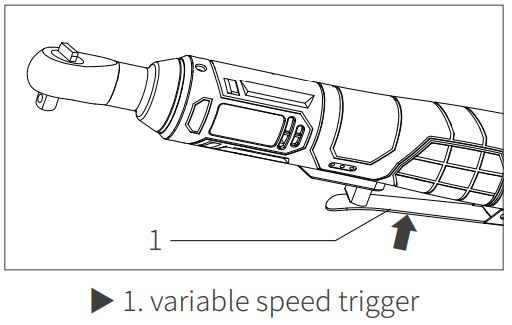
To start the tool, simply pull the variable speed trigger. Tool speed is increased by increasing pressure on the variable speed trigger. Release the speed trigger to stop. To prevent the variable speed trigger from accidentally pulled, the ON/OFF switch is provided
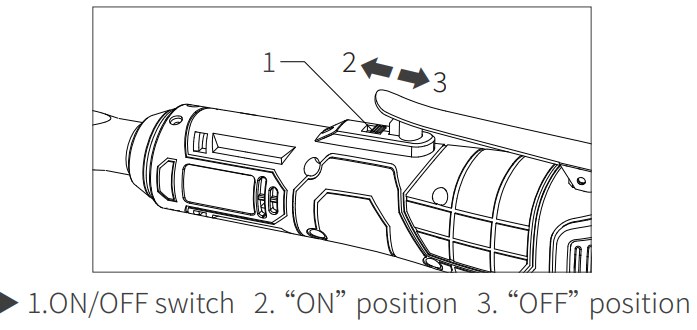
When the ON/OFF switch is in the “OFF” position, the variable speed trigger cannot be actuated. When the ON/OFF switch is in the “ON” position, the speed trigger can be actuated.
CAUTION: When not operating the tool, always slide the ON/OFF switch to the “OFF” position.
Lighting up the built-in LED
CAUTION: Pull the variable speed trigger to light up the built-in LED. The light keeps on lighting while the speed trigger is being pulled. The light automatically goes out approximately seconds after the speed trigger is released.

NOTICE
- When the tool is overheated, the LED light blinks. Cool down the tool fully before operating the tool again.
- Use a dry cloth to wipe the dirt off the lens of the LED light. Be careful not to scratch the tens of the LED light, or it may lower the illumination.
Reversing switch action
CAUTION
- Always check the direction of rotation before operation.
- Use the reversing switch only after the tool comes to a complete stop. Changing the direction of rotation before the tool stops may dam age the tool.
- This tool has a reversing switch to change the direction of rotation. Turn the reversing switch to the F side for clockwise rotation or to the R side for counterclockwise rotation. Make sure that the reversing switch is fully turned with a click sound.

Operation
Hold the tool firmly especially when the bolt/nut reaches the seating position. The socket stops rotating and the motor reaction generate instant backlash to rotate the tool.
NOTICE:Hold the tool pointed straight at the bolt/nut.
Hold the tool firmly and place the socket over the bolt/nut. Turn the tool on and fasten. When the bolt/nut reaches the seating position, the tool stops automatically.
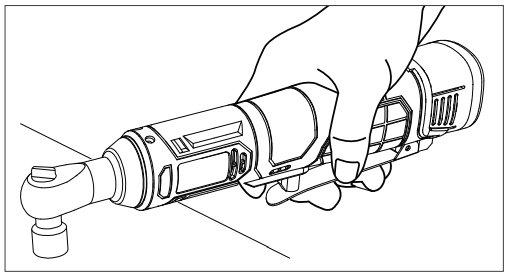
The tool also works without socket. The adapter hole can fasten M8 (5/16”) bolt/nut. (works as 13mm socket)
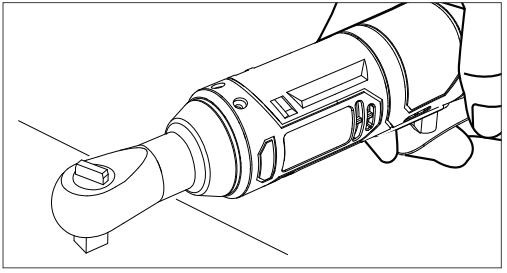
NOTICE
- If you use a spare battery to continue the operation, rest the tool at least 15 min.
- Use the proper bit for the head of the screw/ bolt that you wish to use.
- Hold the tool pointed straight at the screw.
- If the impact force is too strong or you tighten the screw for a time longer than shown in the figures, the screw or the point of the driver bit may be over-stressed, stripped, damaged, etc. Before starting your job, always perform a test operation to determine the proper fastening time for your screw.
Using as a hand tool
You can use the tool as a hand ratchet wrench by turning the tool in the direction arrows as illustrated. In particular when loosening a stiff bolt/nut. loosen it by hand first then turn the tool on.
Maintenance
CAUTION: Always be sure that the tool is switched off and the battery cartridge is removed before attempting to perform inspection or maintenance.
NOTICE:Never use gasoline, benzine, thinner, alcohol or the like. Discoloration, deformation or cracks may result.
To maintain product safety and reliability, repairs, any other maintenance or adjustment should be performed by DINSHARE authorized or factory service centers, always using DINSHARE replacement parts.
Tips for maintaining maximum battery life
- Charge the battery cartridge before completely discharged. Always stop tool operation and charge the battery cartridge when you notice less tool power.
- Never recharge a fully charged battery cartridge. Overcharging shortens the battery service life
- Charge the battery cartridge at room temperature at 10°C - 40°C (50°F -104 °F). Let a hot battery cartridge cool down before charging it.
- When not using the battery cartridge, remove it from the tool or the charger.
- Charge the battery cartridge if you do not use it for a long period (more than six months).
Safety Warnings
General power tool safety warnings
Warning
Read all safety warnings and all instructions. Failure to follow the warnings and instructions may result in electric shock, fire and/or serious injury. Save all warnings and instructions for future reference. The term "power tool" in the warnings refers to your mains-operated (corded) power tool or battery-operated (cordless) power tool.
Work area safety
- Keep work area clean and well lit. Cluttered or dark areas invite accidents.
- Do not operate power tools in explosive atmospheres, such as in the presence of flammable liquids, gases or dust. Power tools create sparks which may ignite the dust or fumes.
- Keep children and bystanders away while operating a power tool. Distractions can cause you to lose control.
Electrical safety
- Power tool plugs must match the outlet. Never modify the plug in any way.
- Do not use any adapter plugs with earthed (grounded) power tools. Unmodified plugs and matching outlets will reduce risk of electric shock.
- Avoid body contact with earthed or grounded surfaces, such as pipes, radiators, ranges and refrigerators. There is an increased risk of electric shock if your body is earthed or grounded.
- Do not expose power tools to rain or wet conditions. Water entering a power tool will increase the risk of electric shock.
- Do not abuse the cord. Never use the cord for carrying, pulling or unplugging the power tool. Keep cord away from heat, oil, sharp edges or moving parts. Damaged or entangled cords increase the risk of electric shock.
- When operating a power tool outdoors, use an extension cord suitable for outdoor use. Use of a cord suitable for outdoor use reduces the risk of electric shock.
- If operating a power tool in a damp location is unavoidable, use a ground fault circuit interrupter (GFCI) protected supply. Use of a GFCI reduces the risk of electric shock.
Personal safety
- Stay alert, watch what you are doing and use common sense when operating a power tool. Do not use a power tool while you are tired or under the influence of drugs, alcohol or medication. A moment of inattention while operating power tools may result in serious personal injury.
- Use personal protective equipment. Always wear eye protection. Protective equipment such as a dust mask, non-skid safety shoes, hard hat or hearing protection used for appropriate conditions will reduce personal injuries.
- Prevent unintentional starting. Ensure the switch is in the off-position before connecting to power source and/or battery pack, picking up or carrying the tool. Carrying power tools with your finger on the switch or energizing power tools that have the switch on invites accidents.
- Remove any adjusting key or wrench before turning the power tool on. A wrench or a key left attached to a rotating part of the power tool may result in personal injury.
- Do not overreach. Keep proper footing and balance at all times. This enables better control of the power tool in unexpected situations.
- Dress properly. Do not wear loose clothing or jewelry. Keep your hair, clothing, and gloves away from moving parts. Loose clothes, jewelry or long hair can be caught in moving parts.
- If devices are provided for the connection of dust extraction and collection facilities, ensure these are connected and properly used. Use of dust collection can reduce dust-related hazards.
Power tool use and care
- Do not force the power tool. Use the correct power tool for your application. The correct power tool will do the job better and safer at the rate for which it was designed.
- Do not use the power tool if the switch does not turn it on and off. Any power tool that cannot be controlled with the switch is dangerous and must be repaired.
- Disconnect the plug from the power source and/or the battery packfrom the power tool before making any adjustments, changing accessories, or storing power tools. Such preventive safety measures reduce the risk of starting the power tool accidentally.
- Store idle power tools out of the reach of children and do not allow persons unfamiliar with the power tool or these instructions to operate the power tool. Power tools are dangerous in the hands of untrained users.
- Maintain power tools. Check for misalignment or binding of moving parts, breakage of parts and any other condition that may affect the power tool’s operation. If damaged, have the power tool repaired before use. Many accidents are caused by poorly maintained power tools.
- Keep cutting tools sharp and clean. Properly maintained cutting tools with sharp cutting edges are less likely to bind and are easier to control.
- Use the power tool, accessories and tool bits etc. in accordance with these instructions, taking into account the working conditions and the work to be performed. Use of the power tool for operations different from those intended could result in a hazardous situation.
Battery tool use and care
- Recharge only with the charger specified by the manufacturer. A charger that is suitable for one type of battery pack may create a risk of fire when used with another battery pack.
- Use power tools only with specifically designated battery packs. Use of any other battery packs may create a risk of injury and fire.
- When battery pack is not in use, keep it away from other metal objects, like paper clips, coins, keys, nails, screws or other small metal objects, that can make a connection from one terminal to another. Shorting the battery terminals together may cause burns or a fire.
- Under abusive conditions, liquid may be ejected from the battery, please avoid contact. If contact accidentally occurs, flush with water. If liquid contacts eyes, additionally seek medical help. Liquid ejected from the battery may cause irritation or burns.
- Do not use a battery pack or tool that is damaged or modified. Damaged or modified batteries may exhibit unpredictable behavior resulting in fire, explosion or risk of injury.
- Do not expose a battery pack or tool to fire or excessive temperature. Exposure to fire or temperature above 130 °C may cause an explosion.
- Follow all charging instructions and do not charge the battery pack or tool outside the temperature range specified in the instructions. Charging improperly or at temperatures outside the specified range may damage the battery and increase the risk of fire.
Cordless electric ratchet wrench safety warnings
- Hold the power tool by insulated gripping surfaces, when performing an operation where the fastener may contact hidden wiring. Fasteners contacting a "live" wire may make exposed metal parts of the power tool "live" and could give the operator an electric shock.
- Always be sure you have a firm footing.
- Be sure no one is below when using the tool in high locations.
- Hold the tool firmly.
- Wear ear protectors.
- Do not touch the bit or the work piece immediately after operation. They may be extremely hot and could burn your skin.
- Keep hands away from rotating parts.
- Use auxiliary handle(s), if supplied with the tool. Loss of control can cause personal injury.
Important safety instructions for battery
Before using battery cartridge, read all instructions and cautionary markings on (1) battery charger, (2) battery, and (3) product using battery.
- Do not disassemble battery cartridge. It may result in a fire, excessive heat, or explosion.
- If operating time has become excessively shorter, stop operating immediately. It may result in a risk of overheating, possible burns and even an explosion.
- If electrolyte gets into your eyes, rinse them out with clear water and seek medical attention right away. It may result in loss of your eyesight.
- Do not short the battery cartridge:
- Do not touch the terminals with any conductive material.
- Avoid storing battery cartridge in a container with other metal objects such as nails, coins, etc.
- Do not expose battery cartridge to water or rain. A battery short can cause a large current flow, overheating, possible burns and even a breakdown.
- Do not store the tool and battery cartridge in locations where the temperature may reach or exceed 50 °C (122 °F).
- Do not incinerate the battery cartridge even if it is severely damaged or is completely worn out. The battery cartridge can explode in a fire.
- Do not nail, cut, crush, throw, drop the battery cartridge, or hit against a hard object to the battery cartridge. Such conduct may result in a fire, excessive heat, or explosion.
- Do not use a damaged battery.
- The contained lithium-ion batteries are subject to the Dangerous Goods Legislation requirements.
For commercial transports e.g. by third parties, forwarding agents, special requirement on packaging and labeling must be observed. For preparation of the item being shipped, consulting an expert for hazardous material is required. Please also observe possibly more detailed national regulations. Tape or mask off open contacts and pack up the battery in such a manner that it cannot move around in the packaging. - Follow your local regulations relating to disposal of battery.
- Use the batteries only with the products specified by DINSHARE. Installing the batteries to non-compliant products may result in a fire, excessive heat, explosion, or leak of electrolyte.
- If the tool is not used for a long period of time, the battery must be removed from the tool.
- During and after use, the battery cartridge may take on heat which can cause burns or low temperature burns. Pay attention to the handling of hot battery cartridges.
- Do not touch the terminal of the tool immediately after use as it may get hot enough to cause burns.
- Do not allow chips, dust, or soil stuck into the terminals, holes, and grooves of the battery cartridge. It may result in poor performance or breakdown of the tool or battery cartridge. ) Unless the tool supports the use near high-voltage electrical power lines, do not use the battery cartridge near high-voltage electrical power lines. It may result in a malfunction or break down of the tool or battery cartridge.
- Keep the battery away from children.
Warranty
DINSHARE provides a One-Year Warranty for products against defects in materials and/ or workmanship under normal use from the date of purchase by the original purchaser ("Warranty Period"), subject to certain exceptions.
This warranty does not apply to damage from repairs made or attempted by anyone other than DINSHARE, misuse, alterations, abuse, lack of maintenance, or accidents. Cordless electric ratchet wrenches need periodic parts replacement and service to achieve the best performance. This warranty does not cover the normal wear and tear with normal use, including but not limited to the surface of the ratchet wrench. Warranty Registration is not necessary to obtain the applicable warranty on a DINSHARE power tool product.
Troubleshooting of Cordless Electric Ratchet Wrench
- If the ratchet wrench is not turning on, check the battery to ensure it is properly charged.
- If the ratchet wrench is not functioning properly, make sure that the chuck is securely attached and that the direction switch is in the correct position.
- If the ratchet wrench is overheating, allow it to cool down before continuing use
- Always use the ratchet wrench in a well-ventilated area and avoid exposure to water or moisture.
Faqs
When charging the Dinshare JC-116 for the first time, how should I do it?
Is it possible to utilise the Dinshare JC-116 for automotive work?
If the charge on my Dinshare JC-116 is not holding, what should I do?
When is the Dinshare JC-116 fully charged, and how can I tell?
Is heavy-duty work appropriate for the Dinshare JC-116?
What kind of upkeep is necessary for the Dinshare JC-116?
How should sockets be attached to the Dinshare JC-116?
What safety measures are recommended for the Dinshare JC-116?
Is it possible to use the Dinshare JC-116 in damp weather?
What is the Dinshare Cordless Electric Ratchet Wrench JC-116's warranty?
Leave a Comment
